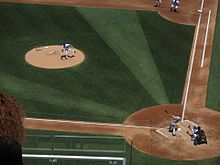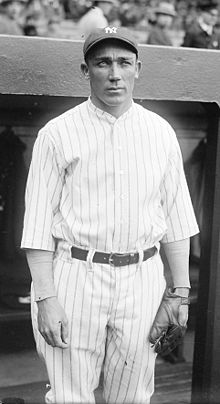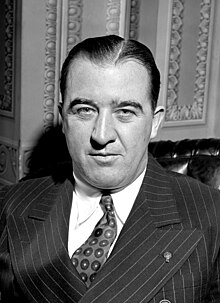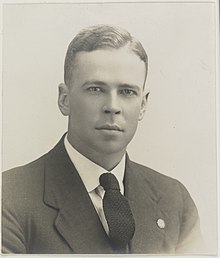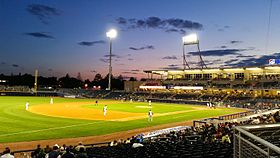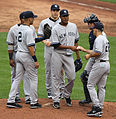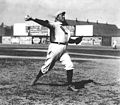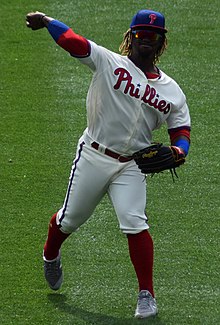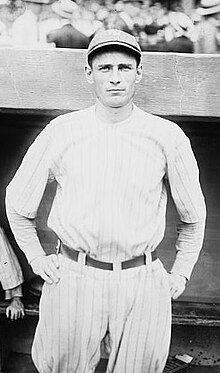Portal:Baseball
Portal maintenance status: (June 2018)
|
| Main page | Content, Categories & Topics | WikiProjects & Things you can do |
The Baseball Portal
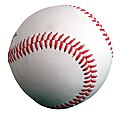
Baseball is a bat-and-ball sport played between two teams of nine players each, taking turns batting and fielding. The game occurs over the course of several plays, with each play generally beginning when a player on the fielding team, called the pitcher, throws a ball that a player on the batting team, called the batter, tries to hit with a bat. The objective of the offensive team (batting team) is to hit the ball into the field of play, away from the other team's players, allowing its players to run the bases, having them advance counter-clockwise around four bases to score what are called "runs". The objective of the defensive team (referred to as the fielding team) is to prevent batters from becoming runners, and to prevent runners advancing around the bases. A run is scored when a runner legally advances around the bases in order and touches home plate (the place where the player started as a batter).
The opposing teams switch back and forth between batting and fielding; the batting team's turn to bat is over once the fielding team records three outs. One turn batting for each team constitutes an inning. A game is usually composed of nine innings, and the team with the greater number of runs at the end of the game wins. Most games end after the ninth inning, but if scores are tied at that point, extra innings are usually played. Baseball has no game clock, though some competitions feature pace-of-play regulations such as the pitch clock to shorten game time.
Baseball evolved from older bat-and-ball games already being played in England by the mid-18th century. This game was brought by immigrants to North America, where the modern version developed. Baseball's American origins, as well as its reputation as a source of escapism during troubled points in American history such as the American Civil War and the Great Depression, have led the sport to receive the moniker of "America's Pastime"; since the late 19th century, it has been unofficially recognized as the national sport of the United States, though in modern times is considered less popular than other sports, such as American football. In addition to North America, baseball spread throughout the rest of the Americas and the Asia–Pacific in the 19th and 20th centuries, and is now considered the most popular sport in parts of Central and South America, the Caribbean, and East Asia, particularly in Japan, South Korea, and Taiwan. (Full article...)
 Featured articles - load new batch
Featured articles - load new batch
-
Image 1
George Herman "Babe" Ruth (February 6, 1895 – August 16, 1948) was an American professional baseball player whose career in Major League Baseball (MLB) spanned 22 seasons, from 1914 through 1935. Nicknamed "the Bambino" and "the Sultan of Swat", he began his MLB career as a star left-handed pitcher for the Boston Red Sox, but achieved his greatest fame as a slugging outfielder for the New York Yankees. Ruth is regarded as one of the greatest sports heroes in American culture and is considered by many to be the greatest baseball player of all time. In 1936, Ruth was elected to the Baseball Hall of Fame as one of its "first five" inaugural members.
At age seven, Ruth was sent to St. Mary's Industrial School for Boys, a reformatory where he was mentored by Brother Matthias Boutlier of the Xaverian Brothers, the school's disciplinarian and a capable baseball player. In 1914, Ruth was signed to play Minor League baseball for the Baltimore Orioles but was soon sold to the Red Sox. By 1916, he had built a reputation as an outstanding pitcher who sometimes hit long home runs, a feat unusual for any player in the dead-ball era. Although Ruth twice won 23 games in a season as a pitcher and was a member of three World Series championship teams with the Red Sox, he wanted to play every day and was allowed to convert to an outfielder. With regular playing time, he broke the MLB single-season home run record in 1919 with 29. (Full article...) -
Image 2

Ian Michael Chappell (born 26 September 1943) is a former cricketer who played for South Australia and Australia. Known as "Chappelli", he is considered as one of the greatest captains the game has seen. He captained Australia between 1971 and 1975 before taking a central role in the breakaway World Series Cricket organisation. Born into a cricketing family—his grandfather and brother also captained Australia—Chappell made a hesitant start to international cricket playing as a right-hand middle-order batsman and spin bowler. He found his niche when promoted to bat at number three. Chappell's blunt verbal manner led to a series of confrontations with opposition players and cricket administrators; the issue of sledging first arose during his tenure as captain, and he was a driving force behind the professionalisation of Australian cricket in the 1970s. He was the captain of the Australian squad which finished as runners-up at the 1975 Cricket World Cup.
John Arlott called him "a cricketer of effect rather than the graces". An animated presence at the batting crease, he constantly adjusted his equipment and clothing, and restlessly tapped his bat on the ground as the bowler ran in. Basing his game on a sound defence learned during many hours of childhood lessons, Chappell employed the drive and square cut to full effect. He had an idiosyncratic method of playing back and across to a ball of full length and driving wide of mid-on, but his trademark shot was the hook, saying "three bouncers an over should be worth 12 runs to me". A specialist slip fielder, he was the fourth player to take one hundred Test catches. (Full article...) -
Image 3Rogers Hornsby tags out Babe Ruth who is caught attempting to steal second base, ending the 1926 World Series.
The 1926 World Series was the championship series of the 1926 Major League Baseball season. The 23rd edition of the Series, it pitted the National League champion St. Louis Cardinals against the American League champion New York Yankees. The Cardinals defeated the Yankees four games to three in the best-of-seven series, which took place from October 2 to 10, 1926, at Yankee Stadium and Sportsman's Park.
This was the first World Series appearance (and first National League pennant win) for the Cardinals, and would be the first of 11 World Series championships in Cardinals history. The Yankees were playing in their fourth World Series in six years after winning their first American League pennant in 1921 and their first world championship in 1923. They would play in another 36 World Series (and win 26 of those), as of the end of the 2023 season. (Full article...) -
Image 4Paschal before a game during the 1925 New York Yankees season
Benjamin Edwin Paschal (October 13, 1895 – November 10, 1974) was an American baseball outfielder who played eight seasons in Major League Baseball from 1915 to 1929, mostly for the New York Yankees. After two "cup of coffee" stints with the Cleveland Indians in 1915 and the Boston Red Sox in 1920, Paschal spent most of his career as the fourth outfielder and right-handed pinch hitter of the Yankees' Murderers' Row championship teams of the late 1920s. Paschal is best known for hitting .360 in the 1925 season while standing in for Babe Ruth, who missed the first 40 games with a stomach ailment.
During his time in baseball, Paschal was described as a five-tool player who excelled at running, throwing, fielding, hitting for average, and power. However, his playing time with the Yankees was limited because they already had future Baseball Hall of Famers Ruth and Earle Combs, and star Bob Meusel, in the outfield. Paschal was considered one of the best bench players in baseball during his time with the Yankees, and sportswriters wrote how he would have started for most other teams in the American League. He was one of the best pinch hitters in the game during the period, at a time when the term was still relatively new to baseball. (Full article...) -
Image 5
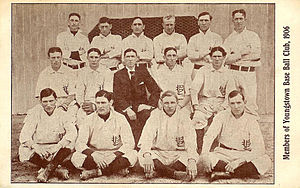
Youngstown Ohio Works (1906), with pitcher Roy Castleton seated in second row, second from left
The Youngstown Ohio Works baseball team was a minor league club that was known for winning the premier championship of the Ohio–Pennsylvania League in 1905, and for launching the professional career of pitcher Roy Castleton a year later. A training ground for several players and officials who later established careers in Major League Baseball, the team proved a formidable regional competitor and also won the 1906 league championship.
During its brief span of activity, the Ohio Works team faced challenges that reflected common difficulties within the Ohio–Pennsylvania League, including weak financial support for teams. Following a dispute over funding, the team's owners sold the club to outside investors, just a few months before the opening of the 1907 season. (Full article...) -
Image 6
Albert Benjamin "Happy" Chandler Sr. (July 14, 1898 – June 15, 1991) was an American politician from Kentucky. He represented Kentucky in the U.S. Senate and served as its 44th and 49th governor. Aside from his political positions, he also served as the second commissioner of baseball from 1945 to 1951 and was inducted into the Baseball Hall of Fame in 1982. His grandson, Ben Chandler, later served as congressman for Kentucky's Sixth District.
A multi-sport athlete during his college days at Transylvania College, Chandler briefly considered a career in professional baseball before deciding to pursue a law degree. After graduation, he entered politics and was elected as a Democrat to the Kentucky Senate in 1929. Two years later, he was elected lieutenant governor, serving under Governor Ruby Laffoon. Chandler and Laffoon disagreed on the issue of instituting a state sales tax and when Chandler, the presiding officer in the state senate, worked to block the legislation, Laffoon's allies in the General Assembly stripped him of many of his statutory powers. The tax then passed by a narrow margin. Knowing that Laffoon would try to select his own successor at the Democratic nominating convention, Chandler waited until Laffoon left the state—leaving Chandler as acting governor—and called the legislature into session to enact a mandatory primary election bill. The bill passed, and in the ensuing primary, Chandler defeated Laffoon's choice, Thomas Rhea. He then went on to defeat Republican King Swope by the largest margin of victory for a Kentucky gubernatorial race at that time. As governor, Chandler oversaw the repeal of the sales tax, replacing the lost revenue with new excise taxes and the state's first income tax. He also enacted a major reorganization of state government, realizing significant savings for the state. He used these savings to pay off the state debt and improve the state's education and transportation systems. (Full article...) -
Image 7

Cobb in 1913
During the 1912 baseball season, center fielder Ty Cobb of the Detroit Tigers was suspended for ten days after entering the spectator stands at New York's Hilltop Park during a game and physically assaulting Claude Lucker, a heckler. At the time, Cobb was among the biggest stars in the major leagues. American League president Ban Johnson suspended Cobb and fined him $50 ($1,600 in 2023).
Cobb had been Lucker's verbal target throughout the four-game series between the Tigers and New York Yankees. Facing a continued stream of insults and questioning about his racial ancestry, Cobb lost his temper in the fourth inning of the fourth game, on May 15, 1912. He raced into the stands, punching and kicking Lucker; Lucker had lost eight fingers in an industrial accident and could not defend himself. Cobb was ejected from the game. Johnson witnessed these events and suspended Cobb indefinitely. Since there were few protections for ballplayers at the time from insults and objects hurled by fans, many took Cobb's side, including his teammates. After defeating the Philadelphia Athletics on May 17, the Detroit players telegraphed Johnson that they would not play again until Cobb was reinstated; Johnson refused to do so. (Full article...) -
Image 8
William Harold Ponsford MBE (19 October 1900 – 6 April 1991) was an Australian cricketer. Usually playing as an opening batsman, he formed a successful and long-lived partnership opening the batting for Victoria and Australia with Bill Woodfull, his friend and state and national captain. Ponsford is the only player to twice break the world record for the highest individual score in first-class cricket; Ponsford and Brian Lara are the only cricketers to twice score 400 runs in an innings. Ponsford holds the Australian record for a partnership in Test cricket, set in 1934 in combination with Don Bradman (451 for 2nd wicket)—the man who broke many of Ponsford's other individual records. In fact, he along with Bradman set the record for the highest partnership ever for any wicket in Test cricket history when playing on away soil (451 runs for the second wicket)
Despite being heavily built, Ponsford was quick on his feet and renowned as one of the finest ever players of spin bowling. His bat, much heavier than the norm and nicknamed "Big Bertha", allowed him to drive powerfully and he possessed a strong cut shot. However, critics questioned his ability against fast bowling, and the hostile short-pitched English bowling in the Bodyline series of 1932–33 was a contributing factor in his early retirement from cricket a year and a half later. Ponsford also represented his state and country in baseball, and credited the sport with improving his cricketing skills. (Full article...) -
Image 9
First Horizon Park, formerly known as First Tennessee Park, is a baseball park in downtown Nashville, Tennessee, United States. The home of the Triple-A Nashville Sounds of the International League, it opened on April 17, 2015, and can seat up to 10,000 people. It replaced the Sounds' former home, Herschel Greer Stadium, where the team played from its founding in 1978 through 2014.
The park was built on the site of the former Sulphur Dell, a minor league ballpark in use from 1885 to 1963. It is located between Third and Fifth Avenues on the east and west (home plate, the pitcher's mound, and second base are directly in line with Fourth Avenue to the stadium's north and south) and between Junior Gilliam Way and Harrison Street on the north and south. The Nashville skyline can be seen from the stadium to the south. (Full article...) -
Image 10Disco Demolition Night was a Major League Baseball (MLB) promotion on Thursday, July 12, 1979, at Comiskey Park in Chicago, Illinois, that ended in a riot. At the climax of the event, a crate filled with disco records was blown up on the field between games of the twi-night doubleheader between the Chicago White Sox and the Detroit Tigers. Many had come to see the explosion rather than the games and rushed onto the field after the detonation. The playing field was so damaged by the explosion and by the rioters that the White Sox were required to forfeit the second game to the Tigers.
In the late 1970s, dance-oriented disco was the most popular music genre in the United States, particularly after being featured in hit films such as Saturday Night Fever (1977). However, disco sparked a major backlash from rock music fans—an opposition prominent enough that the White Sox, seeking to fill seats at Comiskey Park during a lackluster season, engaged Chicago shock jock and anti-disco campaigner Steve Dahl for the promotion at the July 12 doubleheader. Dahl's sponsoring radio station was WLUP (97.9 FM, now WCKL), so admission was discounted to 98 cents for attendees who turned in a disco record; between games, Dahl was to destroy the collected vinyl in an explosion. (Full article...) -
Image 11
Jack Roosevelt Robinson (January 31, 1919 – October 24, 1972) was an American professional baseball player who became the first African-American to play in Major League Baseball (MLB) in the modern era. Robinson broke the color line when he started at first base for the Brooklyn Dodgers on April 15, 1947. The Dodgers signing Robinson heralded the end of racial segregation in professional baseball, which had relegated black players to the Negro leagues since the 1880s.
Born in Cairo, Georgia, Robinson was raised in Pasadena, California. A four-sport student athlete at Pasadena Junior College and the University of California, Los Angeles, he was better known for football than he was for baseball, becoming a star college player with the UCLA Bruins football team. Following his college career, Robinson was drafted for service during World War II but was court-martialed for refusing to sit at the back of a segregated Army bus, eventually being honorably discharged. Afterwards, he signed with the Kansas City Monarchs of the Negro leagues, where he caught the eye of Branch Rickey, general manager of the Brooklyn Dodgers, who thought he would be the perfect candidate for breaking the color line in MLB. (Full article...) -
Image 12

Depiction of the game from The Boston Globe
On Saturday, May 1, 1920, the Brooklyn Dodgers and the Boston Braves played to a 1–1 tie in 26 innings, the most innings ever played in a single game in the history of Major League Baseball (MLB). The game was played at Braves Field in Boston before a crowd estimated at 4,000. Both Leon Cadore of Brooklyn and Joe Oeschger of Boston pitched complete games, and with 26 innings pitched, jointly hold the record for the longest pitching appearance in MLB history. Their record is considered unbreakable, as modern pitchers rarely pitch even nine innings, and newer baseball rules have made long extra-innings games a rarity.
The day of the game saw rainy weather, and it was uncertain if the game would be played, but the skies cleared enough to allow it to proceed. Brooklyn scored a run in the fifth inning, and Boston in the sixth; thereafter, the pitchers became increasingly dominant. As the game exceeded eighteen innings, the small crowd at Braves Field cheered both pitchers. The last twenty innings were scoreless, and when darkness started to fall, the umpires called a halt after the twenty-sixth inning, as baseball fields did not yet have artificial lighting. (Full article...) -
Image 13
Mariano Rivera (born November 29, 1969) is a Panamanian-American former professional baseball pitcher who played 19 seasons in Major League Baseball (MLB) for the New York Yankees, from 1995 to 2013. Nicknamed "Mo" and "Sandman", he spent most of his career as a relief pitcher and served as the Yankees' closer for 17 seasons. A thirteen-time All-Star and five-time World Series champion, he is MLB's career leader in saves (652) and games finished (952). Rivera won five American League (AL) Rolaids Relief Man Awards and three Delivery Man of the Year Awards, and he finished in the top three in voting for the AL Cy Young Award four times. In 2019, he was inducted into the Baseball Hall of Fame in his first year of eligibility, and is to date the only player ever to be elected unanimously by the Baseball Writers' Association of America (BBWAA).
Raised in the modest Panamanian fishing village of Puerto Caimito, Rivera was an amateur player until he was signed by the Yankees organization in 1990. He debuted in the major leagues in 1995 as a starting pitcher, before permanently converting to a relief pitcher late that year. After a breakthrough season in 1996 as a setup man, he became the Yankees' closer in 1997. In the following seasons, he established himself as one of baseball's top relievers, leading the major leagues in saves in 1999, 2001, and 2004. Rivera primarily threw a sharp-moving, mid-90s mile-per-hour cut fastball that frequently broke hitters' bats and earned a reputation as one of the league's toughest pitches to hit. With his presence at the end of games, signaled by his foreboding entrance song "Enter Sandman", Rivera was a key contributor to the Yankees' dynasty in the late 1990s and early 2000s that won four championships in five years. He was an accomplished postseason performer, winning the 1999 World Series Most Valuable Player (MVP) Award and the 2003 AL Championship Series MVP Award, while setting postseason records that included lowest earned run average (ERA) (0.70) and most saves (42). (Full article...) -
Image 14
Marcus Elmore Baldwin (October 29, 1863 – November 10, 1929), nicknamed "Fido" and "Baldy", was an American professional baseball pitcher who played seven seasons in Major League Baseball (MLB). In 346 career games, he pitched to a 154–165 win–loss record with 295 complete games. Baldwin set the single-season MLB wild pitches record with 83 that still stands today.
Born in Pittsburgh, Pennsylvania, Baldwin made his professional debut for a Cumberland, Maryland, team in 1883. Though signed by Chicago White Stockings president Albert Spalding to pitch against the St. Louis Browns in the 1886 World Series, Baldwin did not play after the Browns objected. He made his MLB debut for the White Stockings in 1887, when a writer for the Oshkosh Daily Northwestern called him the "swiftest pitcher in the National League" (NL). Released by Chicago player–manager Cap Anson, he signed with the Columbus Solons of the American Association (AA) in 1889, where he led the league in innings pitched (513+2⁄3), losses (34), strikeouts (368), and walks (274). (Full article...) -
Image 15Los Angeles Angels center fielder Mike Trout hits a home run on a pitch from New York Mets pitcher Tommy Milone on May 21, 2017.
Baseball is a bat-and-ball sport played between two teams of nine players each, taking turns batting and fielding. The game occurs over the course of several plays, with each play generally beginning when a player on the fielding team, called the pitcher, throws a ball that a player on the batting team, called the batter, tries to hit with a bat. The objective of the offensive team (batting team) is to hit the ball into the field of play, away from the other team's players, allowing its players to run the bases, having them advance counter-clockwise around four bases to score what are called "runs". The objective of the defensive team (referred to as the fielding team) is to prevent batters from becoming runners, and to prevent runners advancing around the bases. A run is scored when a runner legally advances around the bases in order and touches home plate (the place where the player started as a batter).
The initial objective of the batting team is to have a player reach first base safely; this generally occurs either when the batter hits the ball and reaches first base before an opponent retrieves the ball and touches the base, or when the pitcher persists in throwing the ball out of the batter's reach. Players on the batting team who reach first base without being called "out" can attempt to advance to subsequent bases as a runner, either immediately or during teammates' turns batting. The fielding team tries to prevent runs by using the ball to get batters or runners "out", which forces them out of the field of play. The pitcher can get the batter out by throwing three pitches which result in strikes, while fielders can get the batter out by catching a batted ball before it touches the ground, and can get a runner out by tagging them with the ball while the runner is not touching a base. (Full article...)
General images - load new batch
-
Image 1A well-worn baseball (from Baseball)
-
Image 2The typical motion of a right-handed pitcher (from Baseball rules)
-
Image 3Jackie Robinson in 1945, with the era's Kansas City Royals, a barnstorming squad associated with the Negro American League's Kansas City Monarchs (from History of baseball)
-
Image 4Alexander Cartwright, father of modern baseball (from History of baseball)
-
Image 5In May 2010, the Philadelphia Phillies' Roy Halladay pitched the 20th major league perfect game. That October, he pitched only the second no-hitter in MLB postseason history. (from History of baseball)
-
Image 6Jackie Robinson in 1945, with the era's Kansas City Royals, a barnstorming squad associated with the Negro American League's Kansas City Monarchs (from Baseball)
-
Image 7Sadaharu Oh managing the Japan national team in the 2006 World Baseball Classic. Playing for the Central League's Yomiuri Giants (1959–80), Oh set the professional world record for home runs. (from Baseball)
-
Image 8The strike zone, which determines the outcome of most pitches, varies in vertical length depending on the batter's typical height while swinging. (from Baseball rules)
-
Image 9Rickey Henderson—the major leagues' all-time leader in runs and stolen bases—stealing third base in a 1988 game (from Baseball)
-
Image 11The standard fielding positions (from Baseball rules)
-
Image 12The NL champion New York Giants baseball team, 1913. Fred Merkle, sixth in line, had committed a baserunning gaffe in a crucial 1908 game that became famous as Merkle's Boner. (from History of baseball)
-
Image 13Baserunners generally stand a short distance away from their base between pitches, preparing themselves to either go back or steal the next base. (from Baseball rules)
-
Image 14Diagram indicating the standard layot of positions (from Baseball)
-
Image 15Pick-off attempt on runner (in red) at first base (from Baseball rules)
-
Image 16The American Tobacco Company's line of baseball cards featured shortstop Honus Wagner of the Pittsburgh Pirates from 1909 to 1911. In 2007, the card shown here sold for $2.8 million. (from Baseball)
-
Image 17Pesäpallo, a Finnish variation of baseball, was invented by Lauri "Tahko" Pihkala in the 1920s, and after that, it has changed with the times and grown in popularity. Picture of Pesäpallo match in 1958 in Jyväskylä, Finland. (from Baseball)
-
Image 19A New York Yankees batter (Andruw Jones) and a Boston Red Sox catcher at Fenway Park (from Baseball)
-
Image 20A first baseman receives a pickoff throw, as the runner dives back to first base. (from Baseball)
-
Image 21Two players on the baseball team of Tokyo, Japan's Waseda University in 1921 (from Baseball)
-
Image 23Pitchers are generally substituted during mound visits (team gatherings at the pitcher's mound). (from Baseball rules)
-
Image 24By the 1860s Civil War, baseball (bottom) had overtaken its fellow bat-and-ball sport cricket (top) in popularity within the United States. (from History of baseball)
-
Image 25Japanese-Americans spectating a World War II-era game while in an internment camp. America's ties to immigrants and to Japan have been deeply shaped by a shared baseball heritage. (from History of baseball)
-
Image 26Diagram of a baseball field Diamond may refer to the square area defined by the four bases or to the entire playing field. The dimensions given are for professional and professional-style games. Children often play on smaller fields. (from Baseball)
-
Image 27A game from the Cantigas de Santa Maria, c. 1280, involving tossing a ball, hitting it with a stick and competing with others to catch it (from History of baseball)
-
Image 28Sadaharu Oh managing the Japan national team in the 2006 World Baseball Classic. Playing for the Central League's Yomiuri Giants (1959–80), Oh set the professional world record for home runs with 868. (from History of baseball)
-
Image 29Cover of Official Base Ball Rules, 1921 edition, used by the American League and National League (from Baseball rules)
-
Image 30A pitcher handing off the ball after being taken out of the game during a mound meeting. (from Baseball)
-
Image 31Cy Young—the holder of many major league career marks, including wins and innings pitched, as well as losses—in 1908. MLB's annual awards for the best pitcher in each league are named for Young. (from Baseball)
-
Image 331906 World Series, infielders playing "in" for the expected bunt and the possible play at the plate with the bases loaded (from Baseball rules)
-
Image 352013 World Baseball Classic championship match between the Dominican Republic and Puerto Rico, March 20, 2013 (from Baseball)
-
Image 37A batter follows through after swinging at a pitched ball. (from Baseball rules)
-
Image 40Baseball games sometimes end in a walk-off home run, with the batting team usually gathering at home plate to celebrate the scoring of the winning run(s). (from Baseball rules)
-
Image 41The strike zone determines the result of most pitches, and varies in vertical length for each batter. (from Baseball)
-
Image 43Fenway Park, home of the Boston Red Sox. The Green Monster is visible beyond the playing field on the left. (from Baseball)
-
Image 44An Afghan girl playing baseball in August 2002 (from Baseball)
-
Image 45A runner sliding into home plate and scoring. (from Baseball)
 Good articles - load new batch
Good articles - load new batch
-
Image 1Vern Donald Freiburger (December 19, 1923 – February 27, 1990) was an American Major League Baseball first baseman who played in two games for the Cleveland Indians on September 6 and September 15 during the 1941 season. At 17 years of age, he was the youngest player to appear in an American League game that season.
Born in Michigan, Freiburger was signed by the Cleveland Indians organization while still in high school. He played one season of minor league baseball, then was given a tryout on the major league roster. After spending 1942 in the minor leagues, he enlisted with the United States Navy to serve in World War II. Upon returning from military service, he returned to the minor leagues, but was no longer considered a major prospect for the Indians, and he proceeded to play in mostly the lower level minor leagues until 1952. Freiburger then retired to California and died in 1990. (Full article...) -
Image 2
Wilbur Forrester Wood Jr. (born October 22, 1941) is an American former professional baseball pitcher. In a 17-year Major League Baseball (MLB) career, he pitched for the Boston Red Sox (1961–64), the Pittsburgh Pirates (1964–65), and the Chicago White Sox (1967–78). A knuckleball specialist after joining the White Sox, he threw left-handed and batted right-handed.
Raised in Belmont, Massachusetts, Wood played several sports in high school and was signed by his hometown Boston Red Sox in 1960. He pitched sparingly for them over parts of four seasons before being traded to the Pittsburgh Pirates in 1964. Seldom-used by the team in 1965, he spent all of 1966 in the minor leagues before being traded to the White Sox. Wood, who had previously relied on a fastball and curveball, refined the knuckleball with the help of veteran knuckleball specialist Hoyt Wilhelm. He spent the next four seasons as a relief pitcher for Chicago. In 1968, he set a record (broken the next year) with 88 games pitched and was named the Sporting News American League (AL) Fireman of the Year. (Full article...) -
Image 3Maglie's 1953 Bowman Gum card
Salvatore Anthony Maglie (April 26, 1917 – December 28, 1992) was an American Major League Baseball pitcher and later, a scout and a pitching coach. He played from 1945 to 1958 for the New York Giants, Cleveland Indians, Brooklyn Dodgers, New York Yankees, and St. Louis Cardinals. Maglie was known as "Sal the Barber", because he gave close shaves—that is, pitched inside to hitters. A gentle personality off the field went unnoticed during games, his foreboding physical appearance contributing to his menacing presence on a pitcher's mound. He was the last of 14 players to play for the Giants, Dodgers and Yankees at a time when all three teams were in New York City. During a 10-year major league baseball career, Maglie compiled 119 wins, 862 strikeouts, and a 3.15 earned run average.
Born and raised in Niagara Falls, New York, Maglie had to play ball secretly growing up because his parents discouraged it. Signed by the Buffalo Bisons of the International League in 1938, he pitched in the minor leagues for five years, then took two years off during World War II to work at a Niagara Falls defense plant. He started pitching again with the Jersey City Giants in 1945, then made his major league debut with the Giants later that year at the age of 28, starting 10 games for the Giants. It would be five years before he returned to the major leagues, as he joined the upstart Mexican League in 1946 and was subsequently blacklisted from Major League Baseball (MLB) for five years by Commissioner Happy Chandler. Not until he was 33 in 1950 did Maglie become a full-time pitcher in the major leagues. (Full article...) -
Image 4
Eric Kevin Bruntlett (born March 29, 1978) is an American former professional baseball utility player. Between 2003 and 2009, he played seven seasons in Major League Baseball (MLB) for the Houston Astros and Philadelphia Phillies.
Born in Lafayette, Indiana, Bruntlett was a shortstop and second baseman for William Henry Harrison High School, with whom he won a state baseball championship in 1995. He played four seasons of college baseball with the Stanford Cardinal, becoming the team's starting shortstop in 1999. After two College World Series appearances, Bruntlett signed with the Astros, who had selected him in the ninth round of the 2000 MLB draft. (Full article...) -
Image 5
Joseph Jerome McGinnity (March 20, 1871 – November 14, 1929) was an American right-handed pitcher in Major League Baseball (MLB) in the late 19th and early 20th century. McGinnity played in MLB for ten years, pitching for the National League's (NL) Baltimore Orioles (1899) and Brooklyn Superbas (1900), before jumping to the American League (AL) to play for the Baltimore Orioles (AL) (1901–1902). He returned to the NL with the New York Giants (1902–1908). McGinnity continued to pitch in the minor leagues, eventually retiring from baseball for good at the age of 54.
In MLB, he won 246 games with a 2.66 earned run average (ERA). He had seven 20-win seasons and two 30-win seasons. Including his time in the minor leagues, McGinnity won close to 500 games as a professional ballplayer. He led MLB in wins five times (1899, 1900, 1903, 1904, and 1906) and ERA once (1904). With the Giants, he won the 1905 World Series. His teams also won NL pennants in 1900 and 1904. (Full article...) -
Image 6
Odúbel David Herrera Jr. (/oʊˈduːbʌl ɛərˈɛərə/ oh-DOO-bull air-RAIR-uh; born December 29, 1991) is a Venezuelan professional baseball center fielder who is a free agent. He has previously played in Major League Baseball (MLB) for the Philadelphia Phillies.
Herrera grew up in Zulia, Venezuela, receiving the nickname "El Torito" (the little bull) from his father as a young baseball player. The Texas Rangers of MLB signed him as an international free agent in 2008, and he began playing the following year in the Dominican Summer League. Herrera spent the next several seasons rising through the Rangers' farm system, including back-to-back Texas League Midseason All-Star honors in 2013 and 2014. The Phillies selected Herrera in December 2014 during the Rule 5 draft. At that point, he had played most of his career at second base, but the Phillies were interested in his potential as an outfielder, and he made the opening day roster in 2015. (Full article...) -
Image 7The Climax Series (クライマックスシリーズ, Kuraimakkusu Shirīzu) is the current annual playoff system implemented by Japan's Nippon Professional Baseball (NPB). It determines which team from the Central League (CL) and from the Pacific League (PL) will advance to compete for the championship in the Japan Series. After the creation of the NPB's two-league system in 1950, the PL experimented with three different playoff systems. In 2004, it implemented the postseason structure from which the Climax Series is based. After three seasons, the CL adopted the same system in 2007, creating the current, unified playoff format.
Both leagues play a regular season, after which the top three teams in each league compete against one another in a two-stage playoff. In the first stage, the teams that finish the regular season with the second- and third-best records play one another in a best-of-three series. The winners of these three-game series advance to the final stage to face each league's regular-season champion in a six-game series, which the regular-season champion starts with a one-game advantage. The winners of each league's final stage series compete against one another in that year's Japan Series. (Full article...) -
Image 8
Clinton Dawson Courtney (March 16, 1927 – June 16, 1975), nicknamed "Scrap Iron", was an American professional baseball catcher who played in Major League Baseball (MLB) for the New York Yankees (1951), St. Louis Browns / Baltimore Orioles (1952–1954, 1960, 1961), Chicago White Sox (1955), Washington Senators (1955–1959) and Kansas City Athletics (1961). He batted left-handed and threw right-handed.
Courtney was born in Louisiana, growing up there and in Arkansas. After serving in the United States Army during World War II, he was signed as a catcher by the New York Yankees. Playing minor league baseball for them for the next few seasons, he was involved in several fights. After one game with the Yankees in 1951, he was traded to the Browns in 1952 at the urging of Rogers Hornsby, St. Louis's manager. Courtney won The Sporting News American League Rookie of the Year, batting .286. Both that season and the next, he was involved in on-the-field fights with Billy Martin, whom he had battled in the minor leagues several seasons before. Courtney remained the starting catcher for the Browns when they moved to Baltimore in 1954 and became the Orioles. Then, he was traded to the White Sox. (Full article...) -
Image 9
Walter Clement Pipp Sr. (February 17, 1893 – January 11, 1965) was an American professional baseball player. A first baseman, Pipp played in Major League Baseball (MLB) for the Detroit Tigers, New York Yankees, and Cincinnati Reds between 1913 and 1928.
After appearing in 12 games for the Tigers in 1913 and playing in the minor leagues in 1914, he was purchased by the Yankees before the 1915 season. They made him their starting first baseman. He and Home Run Baker led an improved Yankee lineup that led the league in home runs. He led the American League in home runs in 1916 and 1917. With Babe Ruth, Bob Meusel, Joe Dugan, and Waite Hoyt, the Yankees won three consecutive American League pennants from 1921 through 1923, and won the 1923 World Series. In 1925, he lost his starting role to Lou Gehrig, after which he finished his major league career with Cincinnati. (Full article...) -
Image 10The world champion Philadelphia Phillies honored at the White House after their 2008 World Series victory
The Philadelphia Phillies' 2008 season was the 126th in the history of the franchise. The team finished with a regular season record of 92–70, first in the National League East. In the postseason, the Phillies won the World Series; this was the first major sports championship for Philadelphia since the 76ers swept the 1983 NBA Finals. During the season, they were managed by Charlie Manuel. To date, this is the most recent season the Phillies won the World Series.
The Phillies opened the season by posting their first winning April since 2003. They also scored 60 runs over 5 games in late May in a sweep over the Colorado Rockies and accrued a 14–4 record over 18 games entering the month of June. The Phillies' performance declined in late June, but they improved after the All-Star break, going 9–6 immediately following the midseason hiatus. Closer Brad Lidge earned eight saves in those games, and did not blow a save throughout the season and the postseason. Philadelphia traded sweeps with the Los Angeles Dodgers in August and went 13–3 in their last 16 games, taking advantage of a late swoon by the New York Mets for the second year in a row to capture the division crown. The team won its position in the playoffs after its second consecutive East Division title. The Phillies also posted the best road record in the National League, at 44–37. (Full article...) -
Image 11
Herbert Eugene Plews (June 14, 1928 – December 12, 2014) was an American Major League Baseball second baseman. He played four years in the majors, from 1956 to 1959 with the Washington Senators and in 1959 for the Boston Red Sox. In the minor leagues he played for Kansas City, Binghamton, Norfolk, and Denver before reaching the majors in 1956, and Toronto, Birmingham, Hawaii, Tacoma, and Arkansas after his major league career ended. During his playing career he served in the military from 1951 to 1952, during the Korean War. Plews batted left-handed and threw right-handed; he was listed as 5 feet 11 inches (1.80 m) tall and 160 pounds (73 kg).
Born in East Helena, Montana, Plews would be (at the time of his death) the only player from the Helena area to reach the major leagues. After four years at the University of Illinois at Urbana-Champaign, he signed with the New York Yankees in 1950. Plews's time in the minor leagues was interrupted by his military service, but he had made it to the Denver Bears (the top affiliate of the Yankees' system) by 1955. After the season, though, he was sent to the Senators in a multi-player trade. Plews debuted with Washington in 1956 and started at second base for them over much of the next three years. Mostly a part-time player in 1959, he was traded to the Red Sox in July, appearing in just 13 more games before being sent to the minors. He played six more years of professional baseball before retiring at the end of 1965. After his baseball career, Plews worked in cement plants, first in Montana and then in the Denver area. He died in 2014. (Full article...) -
Image 12The 2014 National League Wild Card Game was a play-in game during Major League Baseball's (MLB) 2014 postseason played between the National League's (NL) two wild card teams, the San Francisco Giants and the Pittsburgh Pirates. It was held at PNC Park in Pittsburgh, Pennsylvania, on October 1, 2014, starting at 8:07 p.m. EDT. After both teams finished the regular season with identical records of 88–74, the Pirates were awarded home field for the game, as they won the season series against the Giants, 4–2. Despite this advantage, the Giants won by a score of 8–0 and advanced to play the Washington Nationals in the NL Division Series. In addition to being the third NL Wild Card Game played, it is notable for the first postseason grand slam hit by a shortstop. The game was televised on ESPN, and was also broadcast on ESPN Radio. (Full article...)
-
Image 13

Charles Hodes (c. 1848 – February 14, 1875) was an American professional baseball player who played as a catcher, infielder, and outfielder in the National Association for three seasons from 1871 to 1874. A Brooklyn native, Hodes played one season each for the Chicago White Stockings, Troy Haymakers, and Brooklyn Atlantics. He had a career batting average of .231 in 63 total games before dying from tuberculosis in 1875. (Full article...) -
Image 14
Mervyn Roye Harvey (29 April 1918 – 18 March 1995) was a cricketer who played in one Test match for Australia in 1947. His younger brother, Neil, was one of Australia's finest batsmen, and the pair played together for Victoria during the latter part of Merv's career.
Merv Harvey broke into the Victorian state team during the 1940–41 season and played in three first-class matches. The highlight of the first phase of his career for Victoria was a rapid 70 in one hour against a New South Wales attack containing Bill O'Reilly, regarded as the best bowler in the world at the time. However, the outbreak of World War II in the Pacific caused the suspension of top-level cricket and halted Harvey's progress. Harvey then served in the Royal Australian Air Force as an airframe fitter, losing his best cricketing years to the war. (Full article...) -
Image 15Walter Francis O'Malley (October 9, 1903 – August 9, 1979) was an American sports executive who owned the Brooklyn / Los Angeles Dodgers team in Major League Baseball from 1950 to 1979. In 1958, as owner of the Dodgers, he brought major league baseball to the West Coast, moving the Dodgers from Brooklyn to Los Angeles despite the Dodgers being the second most profitable team in baseball from 1946 to 1956, and coordinating the move of the New York Giants to San Francisco at a time when there were no teams west of Kansas City, Missouri. In 2008, O'Malley was elected to the National Baseball Hall of Fame for his contributions to and influence on the game of baseball.
O'Malley's father, Edwin Joseph O'Malley, was politically connected. Walter, a University of Pennsylvania salutatorian, went on to obtain a Bachelor of Laws (LL.B.), and he used the combination of his family connections, his personal contacts, and both his educational and vocational skills to rise to prominence. First, he became an entrepreneur involved in public works contracting, and then he became an executive with the Dodgers. He progressed from being a team lawyer to being both the Dodgers' owner and president, and he eventually made the business decision to relocate the Dodgers franchise. Although he moved the franchise, O'Malley is known as a businessman whose major philosophy was stability through loyalty to and from his employees. (Full article...)
Did you know (auto-generated) - load new batch

- ... that Jenny Cavnar is the first female primary play-by-play announcer in Major League Baseball history?
- ... that in 1915, Walter McCredie unsuccessfully challenged the baseball color line that prohibited non-white players?
- ... that the infield of Garvey, Lopes, Russell and Cey played together longer than any other infield foursome in Major League Baseball?
- ... that Gaylord Perry admitted that he had cheated in baseball in his autobiography Me and the Spitter?
- ... that Zack Kelly received a $500 signing bonus, lost money in his first professional seasons, and was released by two organizations before he made his Major League Baseball debut?
- ... that Park "Saebyeolbe" Jong-ryeol was the first esports player to throw a Major League Baseball opening pitch?
- ... that Dr. Twink Twining was a Major League Baseball player?
- ... that Puerto Rico's Willie Hernández became the highest paid player in Detroit Tigers history after winning Cy Young and Most Valuable Player awards and a World Series?
Quotes
| What we have are good gray ballplayers, playing a good gray game and reading the good gray Wall Street Journal. They have been brainwashed, dry-cleaned and dehydrated!...Wake up the echoes at the Hall of Fame and you will find that baseball's immortals were a rowdy and raucous group of men who would climb down off their plaques and go rampaging through Cooperstown, taking spoils....Deplore it if you will, but Grover Cleveland Alexander drunk was a better pitcher than Grover Cleveland Alexander sober.
— Bill Veeck, Chicago White Sox owner, on the contemporary disfavoring by Major League Baseball executives of players' acting boisterously off-field
|
 Featured lists - load new batch
Featured lists - load new batch
-
Image 1

Ken Griffey Jr. was the first pick overall in the 1987 draft, a 13-time All-Star selection during his career, and a first-ballot Hall of Fame inductee in 2016.
The Seattle Mariners are a Major League Baseball (MLB) franchise based in Seattle, Washington. They play in the American League West division. Since the franchise entered the league as an expansion team in 1977, they have selected 47 players in the first round. Officially known as the "First-Year Player Draft", the Rule 4 Draft is Major League Baseball's primary mechanism for assigning amateur baseball players from high schools, colleges, and other amateur baseball clubs to its teams. The draft order is determined based on the previous season's standings, with the team possessing the worst record receiving the first pick. In addition, teams that lost free agents in the previous off-season may be awarded compensatory or supplementary picks. The First-Year Player Draft is unrelated to the 1976 expansion draft through which the Mariners filled their roster.
Of the 47 players selected in the first round by the Mariners, 18 have been pitchers, the most of any position; of whom 13 were right-handed and five left-handed. They have also drafted nine outfielders, eight shortstops, seven catchers, three first basemen and two third baseman. Seattle has never drafted a second baseman in the first round. The Mariners have drafted 22 players out of high school, and 24 out of college. All of the college selections came from four-year institutions; the team has never selected a junior college player in the first round. The Mariners have drafted 11 players from high schools or colleges in California, four players from Florida, and a single player from their home state of Washington. One of the Mariners' 2007 picks—Canadian Phillippe Aumont—is the only selection from outside the United States. (Full article...) -
Image 2
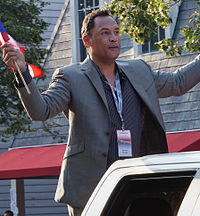
Roberto Alomar leads all second basemen with 10 Gold Glove Award wins.
The Gold Glove Award is the award given annually to the Major League Baseball players judged to have exhibited superior individual fielding performances at each fielding position in both the National League (NL) and the American League (AL), as voted by the managers and coaches in each league. Managers are not permitted to vote for their own players. Eighteen Gold Gloves are awarded each year (with the exception of 1957, 1985, 2007 and 2018), one at each of the nine positions in each league. In 1957, the baseball glove manufacturer Rawlings created the Gold Glove Award to commemorate the best fielding performance at each position. The award was created from a glove made from gold lamé-tanned leather and affixed to a walnut base. Initially, only one Gold Glove per position was awarded to the top fielder at each position in the entire league; however, separate awards were given for the National and American Leagues beginning in 1958.
Roberto Alomar leads second basemen in wins; he won 10 Gold Gloves in 11 years with three different American League teams. Ryne Sandberg has the second-highest total overall; his nine awards, all won with the Chicago Cubs, are the most by a National League player. Bill Mazeroski and Frank White are tied for the third-highest total, with eight wins. Mazeroski's were won with the Pittsburgh Pirates, and White won his with the Kansas City Royals. Joe Morgan and Bobby Richardson each won five Gold Glove Awards, and four-time winners include Craig Biggio (who won after converting to second base from catcher), Bret Boone, Bobby Grich, Orlando Hudson, Dustin Pedroia, and Brandon Phillips. Hall of Famers who won Gold Gloves at second base include Alomar, Sandberg, Mazeroski, Morgan, Biggio and Nellie Fox. (Full article...) -
Image 3

1891 Athletics manager Bill Sharsig
The Philadelphia Athletics were a professional baseball team that existed for two seasons from 1890 to 1891. Known alternatively as the Philadelphia Quakers, and sometimes informally as "Buffinton's Beauties", they played their first season in the newly created Players' League (PL) of 1890, and were managed by Jim Fogarty and Charlie Buffinton. After the demise of the PL following the 1890 season, the team joined the American Association (AA) for the 1891 season, and were managed by Bill Sharsig and George Wood. For each season, the franchise used Forepaugh Park as their home field.
Despite the existence of established major league representation in Philadelphia, the Phillies of the National League (NL) and the Athletics of the AA, the new PL franchise was able to sign veteran players, including Buffinton, Billy Shindle, George Wood, and Ben Sanders. The Quakers finished the season with a 68–63 win–loss record, with one tie, placing them fifth among the eight PL teams. (Full article...) -
Image 4The Major League Baseball Comeback Player of the Year Award is presented by Major League Baseball (MLB) to the player who is judged to have "re-emerged on the baseball field during a given season." The award was developed in 2005, as part of a sponsorship agreement between MLB and Viagra. In 2005 and 2006 representatives from MLB and MLB.com selected six candidates each from the American (AL) and National Leagues (NL) and one winner for each league was selected via an online poll on MLB.com. Since then, the winners have been selected by a panel of MLB beat reporters. Under the current voting structure, first place votes are worth five points, second place votes worth three, and third place votes worth one with the award going to the player with the most points overall. Past winners have often overcome injury or personal problems en route to their award-winning season.
A Comeback Player of the Year Award has been given by The Sporting News since 1965 but its results are not officially recognized by Major League Baseball. Since the beginning of the MLB award in 2005, the recipients have been identical with the following exceptions: 2008 NL (TSN honored Fernando Tatís, MLB honored Brad Lidge), 2010 AL (TSN honored Vladimir Guerrero, MLB honored Francisco Liriano), 2012 AL (TSN honored Adam Dunn, MLB honored Fernando Rodney), 2016 (TSN honored Jose Fernandez and Mark Trumbo, MLB honored Anthony Rendon and Rick Porcello), 2018 NL (TSN honored Matt Kemp, MLB honored Jonny Venters), 2019 AL (TSN honored Hunter Pence, MLB honored Carlos Carrasco), and 2020 AL (TSN honored Carrasco, MLB honored Salvador Pérez). Liriano and Posey are the only players to win the MLB award multiple times with Liriano being the first to win it in each league. (Full article...) -
Image 5The New York Mets are a professional Major League Baseball (MLB) franchise based in New York City, New York in the borough of Queens. They play in the National League East division. In the history of the Mets, there have been 23 managers that managed a game including four interim managers. Of those managers, only Joe Torre was a player-manager (a manager who also plays for the team); Yogi Berra did play four games while he was a coach for the Mets in 1965. Gil Hodges, Roy McMillan, Bud Harrelson, Mike Cubbage, Dallas Green, Bobby Valentine and Willie Randolph all also played in MLB for the Mets prior to becoming the team's manager.
The Mets posted their franchise record for losses in their inaugural season in the league, with 120 losses in 160 games in 1962. This was the first of seven consecutive losing seasons, a season in which the winning percentage was below .500, and the most losses by a post-1900 MLB team. During this stretch from 1962 to 1968, the Mets employed four managers. Seven managers have taken the Mets to the postseason; Davey Johnson, Bobby Valentine and Terry Collins have led the team to two playoff appearances each. Johnson and Gil Hodges are the only Mets managers to win a World Series: Hodges in 1969 against the Baltimore Orioles; and Johnson in 1986 against the Boston Red Sox. Terry Collins is the longest-tenured manager in franchise history, with 1,134 games of service over 7 seasons. (Full article...) -
Image 6Major League Baseball presents a variety of annual awards and trophies to recognize both its teams and its players. Three team trophies are awarded annually: one each to the National League and American League champions, and one of the champion of the World Series. Additionally, various organizations—such as the Baseball Writers' Association of America (BBWAA) and the Office of the Commissioner of Baseball—present awards for such accomplishments as excellence in batting, pitching performance, fielding prowess, and community service.
The Most Valuable Player Award, commonly known as the "MVP", is the oldest individual award, given in its current format since 1931. MVP awards are also presented for performances in the Major League Baseball All-Star Game, the League Championship Series, and the World Series. Offensive awards include the Silver Slugger Award and the Hank Aaron Award, while the Cy Young Award and Major League Baseball Reliever of the Year Award recognize pitching; the Rawlings Gold Glove Award is given for fielding. The newest award is the All-MLB Team, introduced in 2019 to honor the best players at each position across all of MLB. Before that time, the most recently established awards were the Major League Baseball Reliever of the Year Award and Major League Baseball Comeback Player of the Year Award, both established in 2005. Additionally, the Commissioner, at his discretion, can present an Historic Achievement Award for any great contribution to the sport that he deems worthy. (Full article...) -
Image 7

Hard Rock Stadium, the Marlins former home ballpark from 1993-2011
The Miami Marlins are a Major League Baseball (MLB) franchise based in Miami, Florida. They play in the National League East division. The first game of the new baseball season for a team is played on Opening Day, and being named the Opening Day starter is an honor, which is often given to the player who is expected to lead the pitching staff that season, though there are various strategic reasons why a team's best pitcher might not start on Opening Day. The Marlins have used 17 different Opening Day starting pitchers in their 27 seasons. Since the Marlins' first season in 1993, the 17 starters have a combined Opening Day record of 12 wins and 14 losses with two no-decisions. Notably, no Marlins Opening Day starter received a no-decision until the team's 24th season in 2016. No-decisions are only awarded to the starting pitcher if the game is won or lost after the starting pitcher has left the game.
Nine Marlins pitchers have started on two or more Opening Days. Those nine are Charlie Hough, Kevin Brown, Alex Fernandez, Ryan Dempster, Josh Beckett, Dontrelle Willis, Josh Johnson, Ricky Nolasco, and José Ureña. Beckett and Johnson hold the record for most Opening Day starts as a Marlin, with three appearances each, from 2003 to 2005 for Beckett and 2010 to 2012 for Johnson. When playing at their original home field, the venue now known as Hard Rock Stadium, the Marlins had a record of nine wins and five losses (9–5). At their current home of Marlins Park, Opening Day pitchers have a record of 1–5 with one no-decision. In the franchise's history, the Marlins have only played Opening Day games at another team's home stadium eight times. As the away team, Marlins' starting pitchers have an Opening Day record of 1–6 with one no-decision. (Full article...) -
Image 8

Giancarlo Stanton holds 10 records for the Marlins franchise, the most of any Marlins player.
The Miami Marlins are a Major League Baseball (MLB) franchise based in the U.S. state of Florida. The Marlins became members of MLB as an expansion team in the 1993 season. Through 2017, they have played 3,981 games, winning 1,870 and losing 2,111 for a winning percentage of .470. This list documents the superlative records and accomplishments of team members during their tenures as Marlins in MLB's National League East.
Giancarlo Stanton holds the most franchise records as of the end of the 2018 season, with ten records, including both the most career and single-season home runs, RBI, slugging percentage, and total bases records. (Full article...) -
Image 9
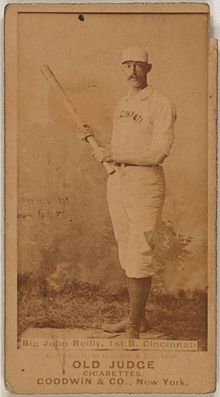
In baseball, completing the cycle is the accomplishment of hitting a single, a double, a triple, and a home run in the same game. In terms of frequency, the cycle is roughly as common as a no-hitter; Baseball Digest calls it "one of the rarest feats in baseball". Collecting the hits in the listed order is known as a "natural cycle".
The cycle itself is semi-rare in Major League Baseball (MLB), having occurred a total of 348 times, starting with Curry Foley in 1882, through Weston Wilson on August 15, 2024. A natural cycle has been completed 14 times in modern MLB history, most recently by Gary Matthews Jr. of the Texas Rangers in 2006. (Full article...) -
Image 10
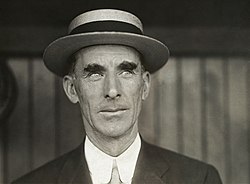
Connie Mack holds the records for most wins (3,731) and losses (3,948) by a Major League Baseball manager.
Major League Baseball (MLB) is the highest level of play in North American professional baseball and is the organization that operates the National League and the American League. In 2000, the two leagues were officially disbanded as separate legal entities, and all of their rights and functions were consolidated in the commissioner's office. Since that time, MLB has operated as a single league. Composed of 30 teams, MLB is one of the four major professional sports leagues in the United States and Canada.
Each team in the league has a manager who is responsible for team strategy and leadership on and off the field. Assisted by various coaches, the manager sets the line-up and starting pitcher before each game and makes substitutions throughout the game. In early baseball history, it was not uncommon for players to fill multiple roles as player-managers; specifically, they managed the team while still being signed to play for the club. The last player-manager in Major League Baseball was Pete Rose, who began managing the Cincinnati Reds in 1984. (Full article...) -
Image 11The Tampa Bay Rays are a Major League Baseball (MLB) franchise based in St. Petersburg, Florida. They play in the American League East division. The first game of the new baseball season for a team is played on Opening Day, and being named the Opening Day starter is an honor, which is often given to the player who is expected to lead the pitching staff that season, though there are various strategic reasons why a team's best pitcher might not start on Opening Day. The Rays have used fifteen different Opening Day starting pitchers in their twenty-six seasons. Since the franchise's beginning in 1998, the fifteen starters have a combined Opening Day record of seven wins, ten losses (7–10), and nine no decisions. "No decisions" are awarded to the starting pitcher if the game is won or lost after the starting pitcher has left the game.
Chris Archer and James Shields holds the Rays' record for most Opening Day starts with four. Archer has one win, two losses, and one no decision, while Shields has one win, one loss, and two no decisions. The all-time record for a Tampa Bay starting pitcher winning an Opening Day game is one, shared by Steve Trachsel, Albie Lopez, Victor Zambrano, James Shields, David Price, Chris Archer, and Shane McClanahan. (Full article...) -
Image 12

Bill Dawley was the starting pitcher for the Sounds' inaugural April 15, 1978, opener.
The Nashville Sounds Minor League Baseball team has played in Nashville, Tennessee, since being established in 1978 as an expansion team of the Double-A Southern League. They moved up to Triple-A in 1985 as members of the American Association before joining the Pacific Coast League in 1998. With the restructuring of the minor leagues in 2021, they were placed in the Triple-A East, which became the International League in 2022. The first game of the new baseball season for a team is played on Opening Day, and being named the Opening Day starting pitcher is an honor which is given to the player who is expected to lead the pitching staff that season, though there are various strategic reasons why a team's best pitcher might not start on Opening Day. The Sounds have used 43 different Opening Day starters in their 46 seasons.
Nashville's first Opening Day game was played against the Memphis Chicks at Tim McCarver Stadium in Memphis, Tennessee, on April 15, 1978. Bill Dawley was their starting pitcher that day; he took the decision in a game the Sounds lost, 4–2. Their first Opening Day game held at home was an 8–7 win against the Birmingham Barons at Herschel Greer Stadium on April 9, 1981. Starter Jamie Werly, who went on to win the Southern League Most Outstanding Pitcher Award that season, did not figure in the decision. On April 4, 2013, starter Tyler Thornburg took a no decision in the final Opening Day game at Greer Stadium, a 5–4 Sounds win. The team left Greer after the 2014 season, but did not play their first Opening Day game at First Horizon Park, their new facility then known as First Tennessee Park, until two years later. In that game, held on April 7, 2016, Sounds starting pitcher Chris Smith was charged with the loss in a 5–0 shutout by the Oklahoma City Dodgers. (Full article...) -
Image 13

In baseball, a home run is credited to a batter when he hits a fair ball and reaches home safely on the same play, without the benefit of an error. Sixty-two different players have hit two home runs in an inning of a Major League Baseball (MLB) game to date, the most recent being Brent Rooker of the Oakland Athletics on May 4, 2024. Regarded as a notable achievement, five players have accomplished the feat more than once in their career; no player has ever hit more than two home runs in an inning. Charley Jones was the first player to hit two home runs in one inning, doing so for the Boston Red Stockings against the Buffalo Bisons on June 10, 1880.
These innings have resulted in other single-inning and single-game MLB records being set due to the prodigious offensive performance. Bobby Lowe and Mike Cameron finished their respective games with a total of four home runs, equaling the record for most home runs in one game. Both of the home runs hit by Fernando Tatís in the third inning for the St. Louis Cardinals on April 23, 1999, were grand slams. Not only did he tie the record for most grand slams in one game, Tatís became the only player to hit two grand slams in the same inning and established a new major league record with eight runs batted in (RBI) in a single inning. A decade later, Alex Rodriguez set the single-inning American League record for RBIs with seven when he hit a three-run home run and a grand slam in the sixth inning for the New York Yankees on October 4, 2009. (Full article...) -
Image 14

The 1901 Nashville Baseball Club won the first Southern Association pennant.
The Nashville Vols were a Minor League Baseball team that played in Nashville, Tennessee, from 1901 to 1963. They were established as charter members of the Southern Association in 1901. Known as the Nashville Baseball Club during their first seven seasons, they became the Nashville Volunteers (regularly shortened to Vols) in 1908. Nashville remained in the Southern Association until the circuit disbanded after the 1961 season. The team sat out the 1962 campaign but returned for a final season in the South Atlantic League in 1963 before ceasing operations altogether. Over 62 seasons, 1,222 players competed in at least one game for the Vols. Of those, 567 also played in at least one game for a Major League Baseball team. Seventeen player-managers served in the role of manager concurrent with their on-field playing.
The Southern Association, of which the Volunteers were members for the entirety of its 61-season run, operated at the Class B (1901), Class A (1902–1935), Class A1 (1936–1945), and Double-A (1946–1961) levels of the minors. The South Atlantic League was at the Double-A level during Nashville's only year of membership. In 35 seasons, the Vols were not affiliated with any Major League Baseball team. Across 27 seasons, they served as a farm club for six major league franchises: the New York Giants (1934–1935, 1952–1954), Cincinnati Reds (1936–1937, 1955–1960), Brooklyn Dodgers (1938–1940), Chicago Cubs (1943–1951), Minnesota Twins (1961), and Los Angeles Angels (1963). The Vols typically owned the majority of their players, and these major league clubs furnished Nashville with additional players to round out the roster. (Full article...) -
Image 15
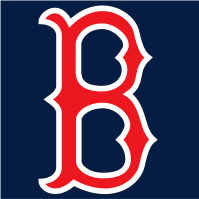
The Boston Red Sox are a Major League Baseball (MLB) team based in Boston, Massachusetts. From 1912 to the present, the Red Sox have played in Fenway Park. The "Red Sox" name originates from the iconic uniform feature. They are sometimes nicknamed the "BoSox", a combination of "Boston" and "Sox" (as opposed to the "ChiSox"), the "Crimson Hose", and "the Olde Towne Team". Most fans simply refer to them as the Sox.
One of the American League's eight charter franchises, the club was founded in Boston in 1901. They were a dominant team in the early 20th century, defeating the Pittsburgh Pirates in the first World Series in 1903. They won four more championships by 1918, and then went into one of the longest championship droughts in baseball history. Many attributed the phenomenon to the "Curse of the Bambino" said to have been caused by the trade of Babe Ruth to the New York Yankees in 1920. The drought was ended and the "curse" reversed in 2004, when the team won their sixth World Series championship. Championships in 2007 and 2013 followed. Every home game from May 15, 2003, through April 10, 2013, was sold out—a span of 820 games over nearly ten years. The team most recently won the World Series in 2018, the ninth championship in franchise history. (Full article...)
More did you know
- ... that Negro league baseball executive Cum Posey organized the East-West League in 1932, but the league folded before the end of the season?
- ... that Freeman Fitzgerald played football with Knute Rockne and once struck out 19 batters in a baseball game?
- ... that despite being named one of the "top prospects of the decade" by Baseball America, American baseball pitcher Nick Neugebauer compiled a career record of just two wins and eight losses?
- ... that Milwaukee Brewers baseball player Dan Thomas was called the "Sundown Kid" because he refused to play on Sabbath?
- ... that when Roger Bresnahan adopted the use of shin guards in Major League Baseball on Opening Day in 1907, angry fans threw snow onto the field?
Sports portals
Selected picture

| Credit: National Photo Company |
Tyrus Raymond "Ty" Cobb (December 18, 1886 – July 17, 1961), nicknamed "The Georgia Peach," was a baseball player and is regarded by some historians and journalists as the best player of the dead-ball era and is generally seen as one of the greatest players of all time. Cobb also received the most votes of any player on the 1936 inaugural Hall of Fame Ballot, receiving 222 out of a possible 226 votes. Cobb is widely credited with setting ninety Major League Baseball records during his career.
Associated Wikimedia
The following Wikimedia Foundation sister projects provide more on this subject:
-
Commons
Free media repository -
Wikibooks
Free textbooks and manuals -
Wikidata
Free knowledge base -
Wikinews
Free-content news -
Wikiquote
Collection of quotations -
Wikisource
Free-content library -
Wikiversity
Free learning tools -
Wiktionary
Dictionary and thesaurus
More portals
- Portals with triaged subpages from June 2018
- All portals with triaged subpages
- Portals with no named maintainer
- Automated article-slideshow portals with 51–100 articles in article list
- Automated article-slideshow portals with 501–1000 articles in article list
- Random portal component with 41–50 available subpages
- Automated article-slideshow portals with 201–500 articles in article list
- Random portal component with 11–15 available subpages
- Random portal component with 21–25 available image subpages

